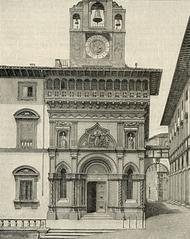Visiting Duomo di Arezzo: Hours, Tickets, and Tips
Date: 18/07/2024
Introduction
Nestled in the heart of Arezzo, the Duomo di Arezzo, officially known as the Cattedrale di San Donato, stands as a monumental testament to the city’s rich history, architectural evolution, and artistic heritage. Constructed over several centuries, this remarkable cathedral offers visitors a unique glimpse into the past, showcasing a harmonious blend of Romanesque, Gothic, and Renaissance architectural styles. The Duomo is not only a center of religious life but also an artistic treasure trove, housing masterpieces such as Piero della Francesca’s fresco cycle, “The Legend of the True Cross” (source). Whether you’re a history enthusiast, an art lover, or simply a curious traveler, the Duomo di Arezzo promises an unforgettable experience. This comprehensive guide will provide you with essential information on visiting hours, ticket prices, travel tips, and nearby attractions to ensure you make the most of your visit to this iconic landmark.
Table of Contents
- Introduction
- Historical Background and Significance
- Visitor Information
- Nearby Attractions
- FAQ
- Conclusion
- References
Historical Background and Significance
Early Beginnings and Romanesque Influences
The site of the Duomo has long been associated with religious structures. Evidence suggests an early Christian church, possibly dedicated to Saint Donatus, existed here as early as the 5th century. However, the first documented structure dates back to the 11th century, a Romanesque edifice built outside the city walls. This early church, though no longer standing, laid the foundation for the grand cathedral that would eventually rise in its place.
A Gothic Statement - Construction Begins
The decision to construct a new, larger cathedral in the Gothic style was made in the 13th century. This period marked a time of significant growth and prosperity for Arezzo, and the Duomo was envisioned as a symbol of the city’s burgeoning power and prestige. Construction began in 1278, with the initial phases focusing on the apse and the lower portions of the nave.
A Protracted Timeline - Centuries of Construction and Transformation
The Duomo’s construction was a protracted affair, marked by periods of intense activity interspersed with lengthy delays. Financial constraints, political upheavals, and the Black Death all contributed to the stop-and-start nature of the project.
-
14th Century - The 14th century saw significant progress, with the completion of the lower part of the façade and the addition of several chapels. This period also witnessed the work of Margaritone d’Arezzo, a prominent local artist who contributed to the Duomo’s early artistic embellishment.
-
15th and 16th Centuries - The Renaissance brought renewed interest in the Duomo, focusing on embellishments and additions. Notable additions from this period include the bell tower, designed by the renowned architect/artist Giorgio Vasari in the 16th century, and the coffered ceiling, a masterpiece of Renaissance woodworking.
-
19th and 20th Centuries - The 19th century saw a renewed interest in Gothic architecture, leading to a significant restoration campaign. This restoration, though well-intentioned, resulted in the removal of some Renaissance-era elements in an attempt to return the Duomo to its perceived Gothic purity. Further restorations in the 20th century aimed to address structural issues and preserve the building for future generations.
The Duomo Today - A Tapestry of Architectural Styles
The Duomo di Arezzo, as it stands today, is not a pure representation of any single architectural style. Instead, it stands as a fascinating blend of Romanesque, Gothic, and Renaissance elements, each layer telling a story of the city’s rich past. This fusion of styles, rather than creating a sense of disharmony, contributes to the Duomo’s unique charm and visual appeal.
Significance and Legacy
The Duomo di Arezzo holds immense significance for the city and beyond:
- Religious Center - As the cathedral of Arezzo, the Duomo remains a vital center of religious life, hosting important services and events throughout the year.
- Artistic Treasure Trove - The Duomo houses a remarkable collection of art and artifacts, including works by renowned artists like Piero della Francesca, whose fresco cycle, “The Legend of the True Cross,” is considered a masterpiece of Renaissance art.
- Architectural Marvel - The Duomo’s architecture, a blend of styles spanning centuries, offers a tangible link to Arezzo’s past, showcasing the evolution of architectural trends and the skills of the artisans who shaped the city’s landscape.
- Symbol of Arezzo - The Duomo, with its towering presence, serves as a powerful symbol of Arezzo’s identity, reflecting the city’s enduring spirit, artistic legacy, and enduring faith.
Visitor Information
Duomo di Arezzo Visiting Hours and Tickets
To fully appreciate the Duomo di Arezzo, plan your visit during its opening hours. The cathedral is generally open from 9 AM to 6 PM, but it is advisable to check the official website for any changes or special events. Tickets can be purchased at the entrance, with prices varying based on age and group size.
Travel Tips
- Best Time to Visit - Spring and autumn are ideal times to visit Arezzo, offering pleasant weather and fewer crowds.
- Guided Tours - Consider joining a guided tour to gain deeper insights into the Duomo’s history and artistic treasures.
- Photography - The Duomo’s intricate details and stunning interiors make it a great spot for photography. Be mindful of any restrictions on flash photography.
Accessibility
The Duomo di Arezzo is accessible to visitors with disabilities, with ramps and elevators available. It is recommended to contact the cathedral in advance for any specific accessibility needs.
Nearby Attractions
While in Arezzo, explore other historical sites such as:
- Piazza Grande - A beautiful medieval square that hosts the monthly antiques market.
- Basilica of San Francesco - Home to Piero della Francesca’s famous frescoes.
- Museo Archeologico - A museum showcasing artifacts from Arezzo’s ancient past.
FAQ
What are the opening hours of the Duomo di Arezzo?
The Duomo is generally open from 9 AM to 6 PM. However, it is best to check the official website for the most current information.
How much do tickets cost for the Duomo di Arezzo?
Ticket prices vary based on age and group size. It is advisable to purchase tickets at the entrance or check online for any available discounts.
Is the Duomo di Arezzo accessible for visitors with mobility impairments?
The Duomo is accessible to visitors with disabilities, with ramps and elevators available. Contact the cathedral in advance for specific accessibility needs.
Conclusion
The Duomo di Arezzo is not just a cathedral; it is a living chronicle of the city’s history, faith, and artistic achievements. From its early Romanesque beginnings to its majestic Gothic and Renaissance flourishes, the Duomo encapsulates centuries of architectural and cultural evolution. Visitors can marvel at the intricate details of the façade, the grandeur of the interior, and the stunning art pieces that adorn the cathedral. As you explore the Duomo, you’ll uncover the stories of the artisans, architects, and patrons who left their mark on this sacred space. Beyond the architectural and artistic wonders, the Duomo remains a vital center of religious life, hosting important services and events throughout the year. Whether you are drawn by its historical significance, its artistic treasures, or its spiritual ambiance, the Duomo di Arezzo offers a profound and enriching experience. Plan your visit today and immerse yourself in the timeless beauty and heritage of Arezzo (source). For the latest updates on visiting hours and tickets, be sure to check the official website or download the Audiala mobile app.





